
(by Michelangelo)
Reprinted from Meridian Magazine 19 Aug 2014, 0 Lord (V), 13 Deer (SR).
©2014 by John P. Pratt. All rights Reserved.
| 1. The Solar System is a Huge Clock |
| 2. Two Hemispheres, Two Witnesses |
| 3. Sacred Calendars |
| 3.1 Ten Discovered So Far |
| 3.2 Holy Days Symbolize Life |
| 4. Network of Witnesses |
| 4.1 Probability |
| 4.2 Independent Events |
| 4.3 Life of Jesus Christ |
| 5. Conclusion |
| Notes |
Sacred calendars have been used to produce a chronology of important religious events throughout history. This article reviews just how that was accomplished and provides illustrations to show that the amazing resultant network of evidence confirms the accuracy of the proposed dates. The chronology of the life of Jesus Christ provides a perfect example.
 |
God told us he designed the lights in the sky to be "for seasons, and for days, and years" (Gen. 1:14). That not only means the sun, moon, planets, and stars are for keeping time in general, but the word translated "seasons" has a double meaning. In other places it is translated in the King James version as "set time" (Gen. 17:21), which this work has shown can refer to "holy days" on sacred calendars.
Sacred calendars are all based on tracking the rotation or revolution of those celestial bodies. The periods of the earth, moon, sun, Venus and Mercury are all so precise that calendars which track them can be used as a "record in heaven" to determine the exact dates on which key events in world history occurred. Hitherto scientists have not even tried to explain the precision of these orbital periods because they have not noticed they are not just random numbers. The work reviewed here clearly shows there must have been a "Watchmaker" to design this magnificent clock.
A brief history of how all of this was discovered should also serve to introduce the entire concept of the celestial witnesses. In 1984 I read in a book of Aztec traditions related to astronomy that they believed that their god Quetzalcoatl resurrected from having been dead a few days at the same that the planet representing him, Venus, also rose in the east, which symbolized its resurrection.[1] The date of the resurrection of Jesus Christ, who has been identified by some as Quetzalcoatl, was already known to me, being Sun 3 Apr AD 33 on our calendar.[2] Checking planetary tables to see if indeed Venus was rising on that Easter Sunday showed that it was high enough to be a blazing morning star. That matched the symbolism in the Bible that the "bright and morning star" represents Christ (Rev. 22:16).
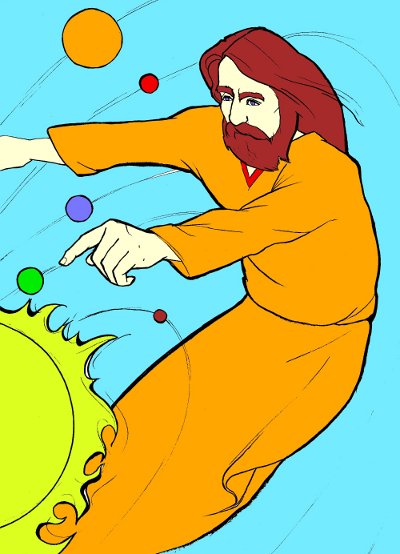 |
That discovery was not only confirming evidence of the date of the Resurrection, which is still in dispute, but also for the identification of the original Quetzalcoatl as being Jesus Christ.
On the Hebrew calendar, it is well known that the Savior was crucified at Passover, at the same time that Passover lambs were sacrificed. It is not so well known that there is a day on the Hebrew calendar for offering a sheaf of the firstfruits of barley from the ground. That day (called the Waving of the Sheaf) represents resurrection in general, and of Jesus Christ in particular, being the firstfruits from the ground (1 Cor 15:20). That day on the calendar given to Moses is the Sunday after Passover (Lev 23:11). Fortunately the Council of Nicea also set the annual date of the Christian Easter to nearly always be the Sunday after Passover. They couldn't have made a better choice, even though the date jumps around between March and April.[3]
So on the Hebrew Calendar of the eastern hemisphere and on the Venus Calendar based on western hemisphere traditions, the Biblical date for the resurrection of Jesus Christ occurred on the exact day on both calendars that symbolizes resurrection. To understand how rare an event that is, Easter only occurs on 1 Resurrection on the Venus Calendar about once in 500 years. It occurred in 2001,[4] but that was the first time in over 500 years, nor will it occur again for 500 years. So the fact that it occurred on the very day indicated by the Bible is a powerful witness that the date is correct. But there are many more witnesses.
The research led to discovering that many of the key events of the Savior's life occurred on holy days on both of those calendars. They are summarized below, and they provide even more powerful evidence that it is far beyond chance for so many alignments to occur. That provides a compelling witness that the dates are indeed correct.
There are many holy days designated on the Hebrew Calendar. Paul explained that the law of Moses "was our schoolmaster to bring us unto Christ" (Gal. 3:24). One way to recognize Him was that He performed sacred ordinances and fulfilled prophecies on the appropriate dates on the Hebrew Calendar. Besides dying and resurrecting on the proper days, other key events were His birth, being presented at the temple on the 40th day of His life according to the law of Moses, the date He began His public ministry, and the date on which He was transfigured in the presence of three of His apostles. But as is discussed below even some events that would appear to be minor were apparently also scheduled on sacred calendars. Events such as being visited by the magi and then fleeing to Egypt and returning to escape Herod's decree to slaughter the infant boys are apparently also included. Thus, this network of events occurring on sacred days on the Hebrew Calendar form a witness that Jesus Christ was indeed the expected Messiah.
On the other hand, or rather, in the other hemisphere, if one checks the dates indicated for each of those events, all of them also occurred on holy days according to calendars used in the Americas, especially on the Sacred Round, used by many Native Americans across both continents. Thus, the dates of these events form a network of witnesses that Jesus was the original Quetzalcoatl of Native American lore. Together with the testimony of the eastern hemisphere, these witnesses provide overwhelming evidence that Christ is indeed both the Messiah and Quetzalcoatl.
The process of discovering just how all of the sacred calendars function is still a work in progress. Some of the calendars were used by ancient civilizations and still are in use today.[5] Others have been modified or perverted and have to be corrected. Some are being discovered from scratch, with no evidence that they were ever actually used by anyone. That is, they are apparently being used by God to calendar important events, but they may never have been known before. For the purposes of this paper, it is not necessary to understand any details of any of them, but it is necessary to at least be familiar with their names and what they are tracking. The purpose of a calendar is to keep track of some celestial body or bodies, to know where they are at any given time. Let's take a brief look at each.
 |
The first five listed keep track of celestial bodies; the last five are simple day counts. That means that the first five require "intercalation", meaning to insert (or skip) extra "leap days" in order to make the periods come out exactly equal to the true cycle length over long periods of time. That is a process that requires discovery and tweaking, and not all of the intercalation procedures are perfectly known to me at this time.[7]
The importance of the calendars listed as tracking "Days" is that they are all simple day counts. They do not track any celestial object (other than the rotation of the earth). That means for each of them, after one historical day is chosen on which their cycle begins, it is never adjusted all during history. Thus, when ten events in the Savior's life all occur on holy days, there is no way to adjust the calendar with a leap day to force it to fit. The other calendars have the potential problem that the "leap days" were inserted incorrectly, but the methods employed in my work are based on simple patterns.
The day counts are like the 7-day week which just keeps counting days and is never interrupted nor changed. Even though we use the week in conjunction with our modern Gregorian calendar, it is actually a separate calendar by itself. In fact, it is the basic unit of several of the calendars in the table.
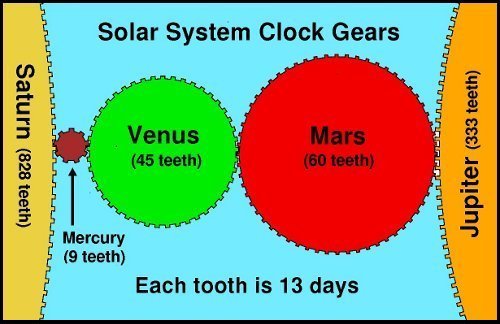 |
The "Unit" listed is the fundamental unit of the calendar. For those tracking something other than days, this is the unit which is intercalated when needed. For example, when the Perpetual Hebrew Calendar needs to be adjusted to track the sun (year) better, an entire month is inserted. Those listing the week as the unit insert an entire week. The Venus calendar skips one trecena about every twenty years to approximate the true Venus cycle of 583.92166 days. The week is the best number of days with which to track the periods of the sun and moon, whereas the trecena is the best unit of time to track the planets. The Enoch and Jubilee Calendars use both: 364 days comprise 52 weeks and also 28 trecenas.
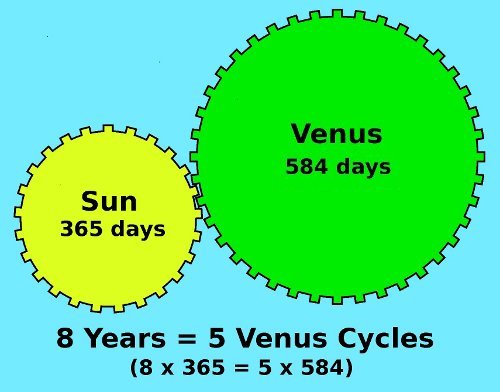 |
Each of the ten sacred calendars discussed here also has a set of holy days. In the Hebrew Calendar, they are pretty much the usual ones known to Hebrews. In the case of the Venus calendar, they correspond to 9 orbital points, such as when Venus is rising or setting or brightest in the sky.
Only recently was it discovered that the holy days on most, if not all, of the calendars all correspond to days in life.[8] That is, the rising of Venus as an Evening Star is its birth and its setting is death. Rising in the east as a Morning Star is resurrection. That part has been known since the beginning of my work, but the recent discovery is that the holy days on the Hebrew Calendar have similar symbolism. For example, the Feast of Tabernacles represents birth when we come to earth to live in a tabernacle of clay.
When we get to the example of the life of Jesus Christ, some of the events of His life happened not only on a holy day on a certain calendar, but also on the very holy day which represents that event. That is a much more rare occurrence. For example, the Resurrection did not just occur on any Hebrew holy day, such as Passover, but on the very day symbolic of resurrection, the Waving of the Sheaf (simply renamed "Easter" in my work).
When an event occurs on a day which is a holy day on more than one calendar, that is an even more rare occurrence. All ten of the events considered in the life of Jesus Christ in this article occurred on a day that was holy on at least four sacred calendars, and many on eight simultaneously which is exceedingly unusual.
Let us now consider how incredibly rare such occurrences are, and what a strong witness that network of events provides that the dates are indeed correct. Let us begin by taking a brief look at estimating probability in order to appreciate how rare it is for events to occur on many holy days simultaneously.
Let's consider some simple laws of probability. Probability is a predicted result one can calculate which assumes the universe is run by "chance". It is based on the ignorance of the observer of a future outcome. For example, people bet on the outcome of a horse race, and the chance of each horse winning is calculated by the laws of probability. But all of that is done before the horse race. If you are watching a video of last year's Kentucky Derby, it doesn't make a lot of sense to bet on the outcome. It's a done deal. The end is known from the beginning of the rerun.
Before Christ was crucified, a bookie could have taken bets on whether Jesus would die at the very hour that the Passover Lambs were being sacrificed in Judea, or whether he would resurrect at the time priests were waving the sheaf of barley. What if the bet included that He must also resurrect on the very day that Venus resurrects as a morning star according to its calendar, which only happens on one day in 585? And what if it had to be on the Resurrection day on three other calendars too? How would you have bet?
If the universe were run by chance, there would be essentially a zero probability that Christ would resurrect at all, let alone at a specific time indicated in a law given to Moses over a thousand years earlier. Apparently no one was expecting Jesus to resurrect at all; even his apostles did not believe it at first. Such a bet might qualify as the biggest "long shot" in history.
Amazingly, He did resurrect at that time, but a moment's reflection shows that it was not just a lucky chance coincidence at all. The event had been planned from before the creation of the earth and it was scheduled ahead on sacred calendars. In other words, there was a 100% chance that it would all turn out as God had planned it. It actually was a sure bet, not a long shot at all!
Before looking at the timing of events in the life of Jesus Christ according to different calendars, it should be noted just what calendars are independent of each other. If a date is known on one calendar, what is the chance of it being a given date on another calendar? If the calendars are independent, then it is sometimes easy to calculate that probability.
 |  |
Of the ten sacred calendars discussed here, only two appear to be totally independent of each other. Those two are the (Perpetual) Hebrew and the Venus. The first is tracking the moon and sun, and is also tied to the week. The other is tracking Venus and is tied to the trecena. Thus any day on the Hebrew Calendar can fall on any day on the Venus Calendar. In the case of the Resurrection discussed above, Easter on the Hebrew Calendar can fall on any of 585 different days on the Venus calendar. Therefore, on the average, the Hebrew Easter only falls on the Venus day 1 Resurrection about once in 585 years.
The other calendars are somewhat dependent on one of those two. If a given day is a holy day on the Venus Calendar, then it always is a holy day on both the Sacred Round and the Mercury Calendar because all three are locked into the same trecena. The point here really is that the calendars are not random, they are designed! Some calendars are not independent from each other at all. The Uniform Enoch and Uniform Jubilee Calendars both have exactly 364 days every year. That means that if a day is holy on both calendars this year then those two holy days will always fall together every year. The sacred calendars were designed to maximize multiple holy days.
Now that that is understood, one can simplify an approximate calculation of how rare multiple holy days are to the simple calculation of just the Hebrew and Venus Calendars, which are independent from each other.
In the case of the calendars there are 32 holy days on the Hebrew calendar which averages 365 days in length, and there are 18 holy days (9 pairs of two consecutive) in 584 average in the Venus cycle. The "chance" (before you look at a calendar!) of any day being holy on both calendars is therefore 32/365 x 18/584, which is about 1/370. That means that one would expect to find one day per year on the average that is holy on both calendars. And indeed that is the case.
On the other hand, if one demands that the day be some specific holy day on both calendars, then it is much more rare. Then then odds are 1/365 x 1/584 which is 1/213,000. But this is a result we have already seen, because 213,000 days is about 584 years. This is just another way to calculate that the Hebrew Easter will only occur on the day Venus resurrects once in about 584 years.
Now we are ready to consider the events in the life of Jesus Christ, and to consider just how unlikely it would be for all of those events to fall on holy days on so many calendars if the orbital periods of the sun (really earth), moon, and Venus were determined by chance.
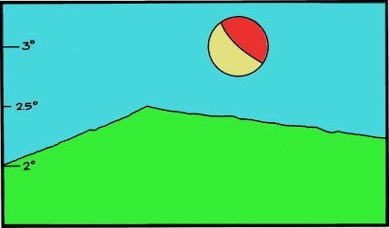 |
The date for the beginning of Christ's public ministry is a secondary anchor date because the Bible explicitly states that Jesus began on the Passover Feast day (John 2:23). The birth date was chosen because it has recently been noticed that Passover is the birthday feast of the Savior.[10] He was baptized at age 30, and Passover of his birth year would have been on Thu 6 Apr 1 BC (there was no year 0 BC). The feast is eaten the night before at the beginning of the Hebrew day. There are several reasons for choosing the dates for the Flight to Egypt. The calendar symbolism was a day of evil, of weeping, and the day to begin a journey. The date for the end of the journey is the counterpart of the beginning and it occurred about a month after Herod's death.[11]
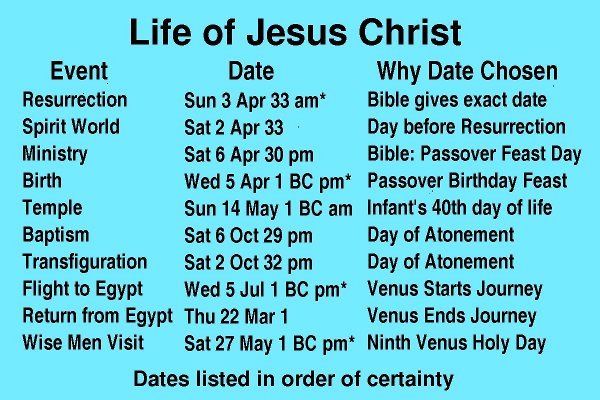 |
Table 2 lists the ten events in the life of Christ being considered, and the proposed date for each. Many dates are known to quarter-day accuracy, where the * means night time (before 6 a.m. or after 6 p.m.). They are listed in the order of certainty, with the first being rock solid. The first seven all have some indication of the date given in the Gospels, the last three are mostly deduced from calendar symbolism. For more detail about why each date was chosen, find the date listed on my Religious Chronology[12] and follow the links to the paper proposing that date.
Now that the reader is familiar with the events, Table 3 lists how many sacred calendars had holy days on the proposed dates, listed in chronological order. In the discussion of probability above, it was noted how much more rare it is for the event to happen on the one or two holy days which either symbolize the event (like being born on the very day for birth) or that was especially meaningful (like the Lord being born on the day 1 Lord). For that reason, days which are bulls-eyes on an exact symbolic day are indicated by a large red "X", whereas if it was just any holy day, the small purple "x" is used.
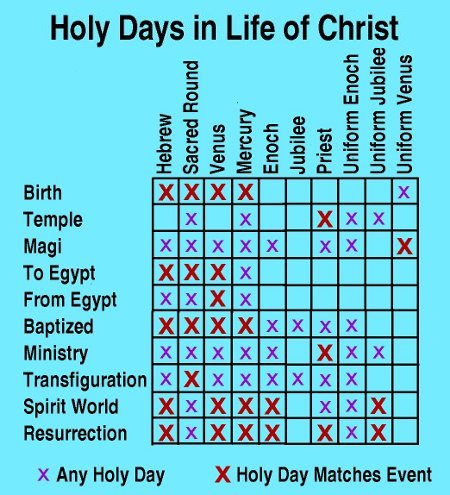 |
Again, the number of the big red X's is the most important, because the probability of so many bulls-eyes happening by chance is negligible. Hopefully the reader is getting the picture that this could not have all happened by chance. All of these super-holy days attest to the correctness of this set of dates, which was derived starting from the historical day of the Resurrection and then using information in the Bible to determine the others. But there is yet another dimension. That is to notice exactly on which holy days each event occurred.
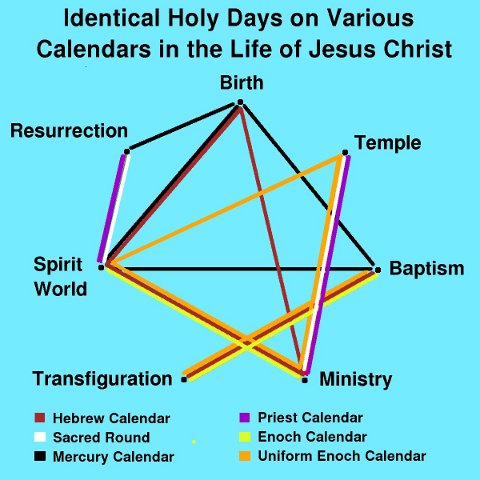 |
It is easy to calculate how often that happens, and no probability is needed. How long does it take those three (day-count) calendars to realign so that all three holy days again occur simultaneously? The answer is, it takes exactly 30 Uniform Enoch years (364 days each). So that event when Jesus was 30 was the first time since his birth that those three holy days occurred together again.
Think about that for a moment. That means that the Temple date which was calculated by counting 39 days from the Savior's proposed birth date just happens to be the one day in thirty years that matches the exact date given in the Bible for the beginning of His ministry. Any one of these results is a strong witness that the proposed dates are correct.
Moreover, notice the symbolism of the Priest calendar, because at both events at the temple, it was the Jeshua (Hebrew for "Jesus") priest who was presiding. So that was not just any holy day on the Priest Calendar, but the day representing the coming of Jesus. Hence the big red X in Table 3 for those events on the Priest Calendar. You see how the chance of this all being random is too hard to believe.
 |
Note also that the Venus Calendar is not listed in the illustration. With it the symbolism was different. Each of the events in the Savior's life occurred on different holy days on the Venus Calendar, such that all nine orbital points are represented.
Looking at the illustration shows how many events of His life occurred on identical holy days, because each line represents such a pair on the same calendar. Note that there are "twin dates" for the Baptism and Transfiguration as well as for the Ministry to the living and the Ministry to the dead in the Spirit World. The richness of the symbolism can boggle the mind.
Another added feature is that there are even more witnesses of these dates, because they also link to many other dates in the chronology in the same way these link to each other. This paper was limited to the mere 33 years of the Savior's life.
An example of a link to another date is given in the publication date of this article: Tue 19 Aug 2014. Today is the holy day 0 Lord on the Venus Calendar, which completes 1,260 Venus cycles since the proposed birth date of Christ on 1 Lord. Today also is the holy day 13 Deer on the Sacred Round. It begins the 260th round of 260 days from the day Tue 6 Apr 1830 (13 Deer), on which was the birth of the LDS Church. Many believe that the LDS Church was born on the same day as Christ (6 Apr), which agrees with the findings of this paper. Thus, today is linked on two sacred calendars to the birth date of Christ. Those links did not happen by chance, they were planned.
Ten sacred calendars have been discovered and are briefly discussed and compared. Each has holy days, which are symbolic of steps in life, such as birth, death and resurrection. Results from many previous articles are then reviewed for the most probable dates of such key events in the Savior's life. The amazing result is then reviewed that ten of those dates fall on holy days on many of those sacred calendars simultaneously, often on the exact day of the cycle designated for that very event. The odds against so many coincidences happening by chance is overwhelmingly small, providing compelling evidence that most of the proposed dates are indeed correct.